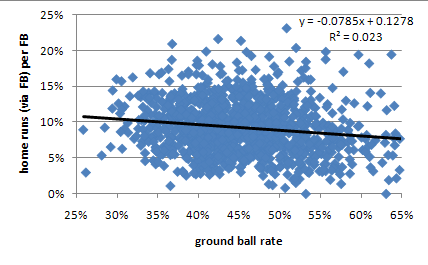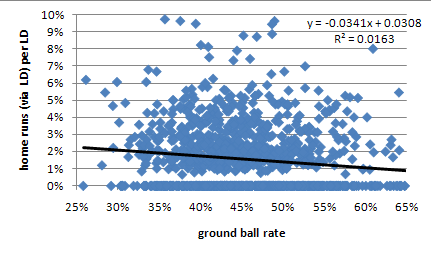As we can expect in most cases, the headline overhyped the content. MLB.com’s Steve Gilbert, reporting on Diamondbacks GM Josh Byrnes’s Q&A at FanFest last weekend, quoted the GM on the issue of contract extensions for Mark Reynolds and Justin Upton. His answer was unsurprisingly ambiguous, though the copy editor played it up a bit in the headline. Seeing that headline, after finding through an equally tantalizing MLBTR headline, made me wonder what it would take to lock up Upton, through his arbitration years and perhaps a year into his free agency.
Using WAR dollars
Since we don’t know how Upton will fare this season, I’ll base my hypothetical on the Fans projection. Why Fans and not CHONE? Because the Fans projection is considerably more bullish, projecting Upton to produce a full win over his 2009 performance. I’m not sure if he’ll truly break out this season, but given all we’ve heard about him since the Diamondbacks drafted him with the No. 1 overall pick in 2005, I think it works for these informal purposes.
The Fans project Upton to post 5.6 WAR this season, based on an improvement of 10 batting runs above replacement. Converting WAR to dollars, that’s a $25.1 million performance. Again, given Upton’s upside, he could further improve on that through his arbitration years, though his positional adjustment doesn’t help. So let’s proceed figuring Upton hits most of his upside and produces ~6 WAR per season, which would put him around $27 million in WAR dollars.
Problem is, only one man makes that much money. Albert Pujols might become the second once he hits free agency, but in both cases we’re talking about generational talents. Like the Fans I’m bullish on Upton, but not quite ready to pronounce him A-Rod or Pujols. But, since the header says WAR dollars, let’s work backward from here anyway.
If we go by the rule of thumb, with a player’s first-year arbitration being 40 percent of his free-agent value, the second year being 60 percent, and the third year being 80 percent, we can make some pretty quick estimates of Upton’s arbitration salary. In 2011 he’d make $10.8 million, in 2012 $16.2, and in 2013 $21.6. Right away these numbers jump out as well higher than we’d expect, given recent arbitration hearing results. Then again, Ryan Howard did get $10 million in his first arbitration hearing, and Upton would be much younger. But, since teams sign long-term deals require a monetary sacrifice to the team in exchange for security, we can adjust this down, perhaps considerably.
Figuring a four-year contract, buying out all three arbitration years and a year of free agency, WAR dollars adjusted for arbitration would come out to four years, $75.6 million. If we adjust that down, say, 25 percent, it’s a four-year, $56.7 million contract. That still seems a bit rich. Even if Upton deserves it, I’m not sure the D’Backs would pay it.
Comparable players
When hashing out arbitration figures, teams and players make comparisons to similar players. Teams will obviously look t players at the lower end of that spectrum, while the players will try for the best. Since we’re looking for terms of a long-term deal, four to five years, maybe some comparable deals from team-controlled players could shed some further light.
In 2008 Hanley Ramirez signed an extension that started with his first arbitration eligible season, 2009, and runs through 2014. Those six years will cost the Marlins, or a potential acquiring team, $70 million. Hanley was two years older than Upton through his first two major league seasons, which could change the equation. On the other hand, Ramirez produced more value in his first two seasons, 4.5 and 5.7 WAR against Upton’s 0.7 and 4.6. If Upton produces to the level of Fan projection, perhaps he’d be in line for something similar.
More on Upton’s level positionally, Ryan Braun signed an eight-year, $45 million extension with the Brewers a month and a half into his first full season. The deal essentially pays him $4, $6, and $8.5 million for his arbitration years, so I don’t think this is a good comp at all. Since Upton already has more service time than Braun did when he signed, that should be relatively obvious. We can also turn aside Evan Longoria as a comp, for similar reasons. Ditto Grady Sizemore and Troy Tulowitzki.
How about David Wright? He signed an extension while finishing up his second full season in 2006. It bought out his first two arbitration years at $5 and $7.5 million, and buys out his final one for $10 million. It also buys out his first two years of arbitration for $14 and $15 million, plus a $16 million club option for 2013. Wright produced 5.8 WAR in 2005 and 4.6 WAR in 2006, close to what Upton did in 2009 and what we can loosely project for 2010. Of course, Upton might not want to sign away two to three free agent years, so maybe some of those dollars can go back into arbitration values.
Taking a stab at the issue, using the WAR dollars projection plus the Ramirez and Wright comps, a five-year, maybe a five-year, $58 million deal would get the job done. That provides Upton with security, and the Diamondbacks with a predictable salary plus two years of free agency. Upton would be 28 when the deal expires, so he could pursue a pretty hefty contract, perhaps in the range of Mark Teixeira’s eight-year, $180 million deal.
Clearly this was just the exploration of a curiosity, and by no means represents what the Diamondbacks should pay Upton should they want to lock him up. I’m interested to see others take a stab at estimating his value over the next four or five years.



